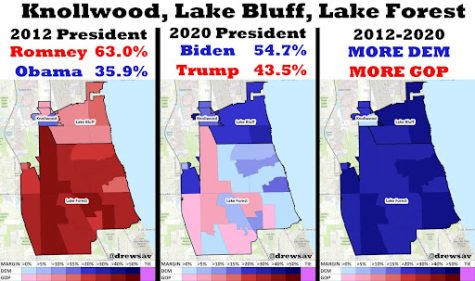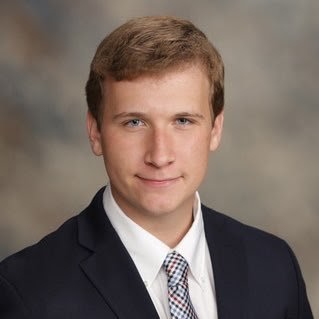The Rapidly Changing Politics of Lake Forest and Lake Bluff

Like much of the rest of the US, Lake Forest and Lake Bluff have seen an increase in political partisanship over the last decade.
February 11, 2022
In the past few years, America has seen unprecedented political turbulence that has brought what happens in Washington DC into every home, onto every computer screen, and every phone touchscreen.
At the core of this shift has been a new rise in political division between Republicans and Democrats.
This polarization does not necessarily mean red areas getting redder and blue areas getting bluer. Rather, it’s a shift based on education, region, money, and demographics.
The communities of Lake Forest and Lake Bluff show this perhaps more strongly than anywhere else.
For a long time, Lake Forest and Lake Bluff were very Republican communities. They were painted as the textbook example of “Country Club Republicans”.
Until very recently, the Republican Party (also known as the GOP, or “Grand Old Party”) was deeply correlated with wealth and affluence.
From the beginning of the 20th century, the Republican Party has been a foremost champion of tax cuts, especially for wealthier Americans, and deregulation of commerce—positions which benefit more financially well-off Americans.
Meanwhile, the Democratic Party has been known for its support of higher taxes on the rich to benefit welfare programs and increasing funding for healthcare and education. These are positions which were met more favorably by the American working class and poor.
Thus, the GOP was considered the party of the wealthy and upper middle class, and Democrats, the party of the working poor.
Being very wealthy, upscale communities home to lots of business owners and executives, Lake Forest and Lake Bluff were very solidly Republican communities, being a major source of Republican votes, donations, and politicians in the state of Illinois for decades.
That old dichotomy in American politics changed in the 21st century, culminating in 2016 with the rise of Donald Trump and his unique brand of politics. Starting in the 1990’s, social politics became more split up by party.
Since as far back as the 1980s, the Republican Party has become more explicitly socially conservative, touting increasingly pro-life and anti-gay marriage (the latter has been dropped in the last decade) positions, and the Democratic Party became more socially liberal, sporting increasingly pro-choice and pro-LGBT positions.
With this shift, the formerly widespread conservative Democrats and liberal Republicans found themselves defecting to the opposite parties.
This culminated in 2016 with Donald Trump’s nomination to lead the GOP in the presidential election that year.
Trump was very different ideologically from the historical Republican Party. He was very vocal in his opposition to globalism, which includes free-trade deals like NAFTA (North American Free Trade Agreement) and the TPP (Trans Pacific Partnership) which were blamed for the outsourcing of American manufacturing jobs, and he was highly opposed to mass immigration.
He railed against “elites” and gave notes of support to both economic regulation and labor unions—positions which were unheard of for a Republican who’s party still vehemently opposed unions and economic regulation.

Both free-trade economics and immigration were met favorably by the types of affluent, business-oriented Republicans that populated Lake Bluff and Lake Forest, and thus the Republican Party failed to resonate on those issues.
Trump was also very socially conservative, and the Republicans of Lake Bluff and Lake Forest tend to be more socially liberal than Republicans nationwide. In Republican presidential primaries, the communities have sided with the most moderate candidate every time, voting for Mitt Romney over social conservative Rick Santorum in 2012, and John Kasich over hardliners Donald Trump and Ted Cruz in 2016.
These communities are also very well educated, and data shows Republicans doing increasingly worse among voters with college degrees nationwide, and increasingly better with those without degrees. Finally, Trump brought with him a bombastic personality that many Lake Forest and Lake Bluff residents weren’t interested in hearing.
This change in the politics being promoted by the Republican Party has resulted in a massive shift in how Lake Forest and Lake Bluff have voted.
In the 2016 election, both communities shifted strongly to the Democratic Party, though not as drastic as it could have been because of the unpopularity of the Democratic nominee, Hillary Clinton.
In 2020, with Trump being a very unpopular incumbent President and the Democrats nominating a more popular nominee in Joe Biden, the dam broke and Lake Forest and Lake Bluff both voted Democratic, the first time both towns did so in modern history.
Knollwood, however, didn’t shift as hard as Lake Forest and Lake Bluff, and between 2012 and 2016 it actually swung to the Republican side.
Where Trump’s politics failed among affluent voters, they found traction among the white working class that felt blown off by decades of two party establishment rule, who saw immigration and globalism as taking away jobs and opportunity.
Knollwood, being a more working class community, likely didn’t shift as much for this reason.
This dynamic is how Trump flipped blue collar states like Ohio, Wisconsin, Michigan, and Pennsylvania, ultimately winning the presidency with their electoral votes.
Another interesting observation is that state-level Republican candidates are still doing quite well in the communities of Lake Forest and Lake Bluff.
In 2018, incumbent Republican governor Bruce Rauner won both Lake Forest and Lake Bluff in the gubernatorial election that year, performing much better than Trump did in the presidential election two years prior. In 2020, the Republican nominee for U.S. Senate Mark Curran won Lake Forest and outperformed Trump in every precinct in Lake Forest and Lake Bluff. Despite the community’s hostility towards Trump, it still tends to vote positively towards local Republicans.
The community also overwhelmingly voted against the Democratic backed “Fair Tax” amendment in 2020. The only precinct which voted for it was Knollwood.
The referenda in question would have empowered the state government to end the current flat tax and implement a graduated income tax, a stable of Democratic, progressive economic policy.
The plan was backed by Gov. Pritzker and vehemently opposed by the state GOP. The communities of Lake Forest and Lake Bluff voting against it showed that they are still not beholden to the state Democratic party.
As national politics continue to evolve, it is likely that we will see the voting patterns of Lake Forest, Lake Bluff, and Knollwood continue to change. We may see the community voting in very different ways going forward.
Only time will tell.
One thing is for sure, the rapid change of the politics of the community in the past 10 years shows that the transformation is far from over.







Gregor Sharp • Feb 28, 2022 at 11:09 am
This is actually one of the most informative reporting I’ve seen on local politics in a long while, I really hope you’re able to continue this in the future as you’re one of the best reporters I’ve been reliant on for information in a long time, especially on political analytics! <3
Lynne • Feb 17, 2022 at 4:42 pm
Thoughtful and informative! Great job Gabe! Can’t wait to see where you choose to go in the years ahead!
michael • Feb 13, 2022 at 8:41 am
Incredibly well thought out and unbiased political synapsis of our political community. Very impressive analysis and writing. I am looking forward to reading more!!
Mary Faith Terkildsen • Feb 16, 2022 at 11:16 am
Completely agree- great work!
Marlo Campbell • Feb 11, 2022 at 11:55 am
Very well written!
Tim G. • Feb 13, 2022 at 7:58 pm
Better than 99% of political articles I see in the NYT/WPost these days.
Spelling and grammar is also way better quality than either of theirs has been lately, heh.